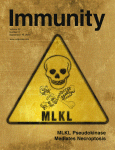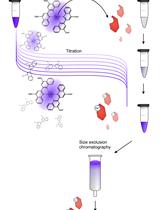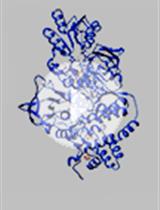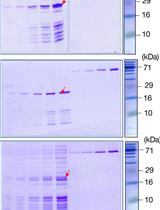- EN - English
- CN - 中文
Determination of Pseudokinase-ligand Interaction by a Fluorescence-based Thermal Shift Assay
荧光热变分析测定假激酶配体的相互作用
发布: 2014年06月05日第4卷第11期 DOI: 10.21769/BioProtoc.1135 浏览次数: 13386
评审: Anonymous reviewer(s)
Abstract
This protocol describes a robust technique for the measurement of pseudokinase-ligand interaction by a fluorescence-based Thermal Shift Assay (TSA). Pseudokinases are kinase-like proteins that have recently emerged as crucial regulators of signal transduction and may therefore represent a novel class of drug targets. Unlike kinases, the catalytic efficiency of pseudokinases is rather poor or non existent, making it difficult to dissect the function of their nucleotide binding sites. Thermal denaturation-based methods have proven to be a powerful method for determining ligand binding capacity to purified pseudokinases and can inform on the potential drugability of the nucleotide binding site. This assay takes advantage of a change in flurorescence arising when a flurorescence dye, in this instance SYPRO® Orange, binds to hydrohobic patches that become exposed when a protein undergoes thermal denaturation. Ligand binding to a protein is known to increase its thermal stability which is reflected by a shift observed in the thermal denaturation curve between the unliganded protein and the liganded protein. This generalized protocol can also be tailored to other protein families. In addition, thermal denaturation-based methods can be used to identify optimal buffer conditions that may increase protein stability.
Materials and Reagents
- Purified protein (stock solution preferably at a concentration above 20 μM) (Murphy et al., 2013)
- 1 M Dithiothreitol (DTT) stock (Astral Scientific, catalog number: C-1029 )
- DMSO (high grade) (Sigma-Aldrich, catalog number: D-1435 )
- MilliQ water
- Nucleotide solutions (10 mM stock prepared in 20 mM Tris) (pH 8)
- Divalent cations salt solutions (50 mM stock in MilliQ water)
- Kinase inhibitor solutions (2 mM stock in 100% DMSO) (such as the pan-kinase inhibitors, Staurosporine, Sigma-Aldrich, catalog number: S5921 )
- Thermal Shift Assay buffer (see Recipes)
- SYPRO® Orange (Sigma-Aldrich, catalog number: S5692 ) (see Recipes)
Equipment
- RT-PCR tubes GST-RG01 (Gene Targets Solutions)
- 1.5 ml microfuge tube
- Qiagen/Corbett Rotor-Gene® 3000 RT-PCR machine (QIAGEN) (Murphy et al., 2013)
Software
- Microsoft Excel or Prism
Procedure
文章信息
版权信息
© 2014 The Authors; exclusive licensee Bio-protocol LLC.
如何引用
Lucet, I. S., Hildebrand, J. M., Czabotar, P. E., Zhang, J., Nicola, N. A., Silke, J., Babon, J. J. and Murphy, J. M. (2014). Determination of Pseudokinase-ligand Interaction by a Fluorescence-based Thermal Shift Assay. Bio-protocol 4(11): e1135. DOI: 10.21769/BioProtoc.1135.
分类
生物化学 > 蛋白质 > 荧光
生物化学 > 蛋白质 > 相互作用 > 蛋白质-配体相互作用
您对这篇实验方法有问题吗?
在此处发布您的问题,我们将邀请本文作者来回答。同时,我们会将您的问题发布到Bio-protocol Exchange,以便寻求社区成员的帮助。
Share
Bluesky
X
Copy link













